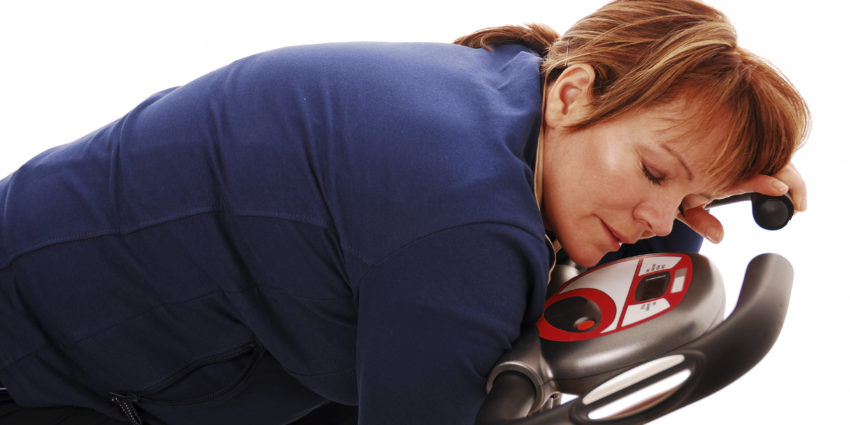Most women experience weight gain as they age, due to a slower metabolic rate. What we need to focus on is not weight loss, but how to raise your sluggish metabolism.
From a more sedentary lifestyle, to hormones and poor food choices, it seems like weight gain is an endless battle for most. When we are young, most of us never have to think of how to eat, or whether we are burning calories or not. Our bodies used to work fine, without us ever thinking about it.
Once we are past 30, things seem to slow down. With the birth of a child, or a few more candles on the cake…what once was something that happened naturally, is now constantly a struggle. Unfortunately, women make many mistakes when trying to lose weight, and end up feeling miserable, making dieting an ongoing cycle. When menopause approaches, we are already usually unhappy with how we look and how we feel, and think that a fit and lean body is something reserved for youth.
Every day there is a new diet plan that is supposed to give us the results we are seeking. Instead, those quick fixes contribute to slowing down our metabolic rates, and sabotage our goals.
Fortunately, a metabolic rate can be changed to work in your favor, instead of against you. A sluggish metabolic rate can be re-booted and kickstarted, no matter what your age, or what you have tried before.
Even if everyone in your family has battled weight gain, you do not have to. We know now, that we can “trick” our gene pool and turn our body from a fat storing machine, to a fat burning machine.
Fist let’s cover what things slow down a metabolic rate, and what practices speed up your metabolism.
- Muscle burns calories. AND, Bigger muscles burn more calories.
What this means is the more muscle you have on your body, the faster your resting metabolic rate. Muscle is metabolically active tissue, and is like a “furnace” that burns calories…even while you are at rest.
There are thin people that are actually not fit and can be “flabby”. This should not be confused with healthy or fit. These people can actually appear to seem fit, when in fact they are actually weak and will not age well.
One of the best things you can do is to build lean muscle tissue. This doesn’t mean you have to spend hours in the gym, and it definitely does not mean doing hours of cardio, What is key to building lean muscle tissue (at any age) is to work your bodies biggest muscles and place a demand on them that they are not used to.
Doing exercises that involve your legs, glutes, (rear end) back and chest are the key to growing bigger and more functional muscles. Not only will you create a stronger body, with better posture, but a leaner and fitter body.
Doing moves that involve squatting, lifting, pressing and pulling with these muscles in a controlled manner is what will “ignite” those muscle fibers and help them grow. As you get stronger and your muscles adapt to the exercise, you can add more weight, or place a harder demand on your bod to create larger and more toned muscles so that you can raise your slow metabolic rate.
Women do not need to fear getting “too big” as we do not have the high amounts of testosterone that men do. If you keep lifting and using your biggest muscles you will get stronger and raise your metabolic rate. You will sculpt and tone your body, and flatten and strengthen your core. This will not only raise your metabolic rate, but make you appear to be years younger!
2. Eating protein feeds muscles.
All cells need certain nutrients to survive. Without protein, muscle tissue wastes away. Without muscle tissue, the body grows weaker with age, posture is compromised and your metabolic rate slows down.
In order to build, keep and repair lean muscle tissue. It is recommended by the DRI (dietary reference intake) that an average sedentary woman take in approximately 46 grams of protein per day. This is based on a person that has little to no activity. When we look at the first tip in this post, we remember that we are trying to build lean muscle tissue by placing a demand on the body, so that it can build new muscle. This is done by adding in strength training so that you can not only raise your metabolic rate, but to be strong and vital as you age.
To feed and repair this newly built muscle tissue, it is recommended by fitness professionals that you get approximately 1 gm, per lean pound of bodyweight. More if you are extremely active and do strenuous weight lifting or have a very active lifestyle and are involved in sports. Any less that that, and your muscles will deteriorate as they won’t have enough fuel to keep them alive.
Since exercise actually breaks down muscle fibers, it is the intake of protein that feeds the fibers to repair, and grows new muscle tissue.
Protein can come from different sources. A combination of animal and plant protein is recommended. A quality whey based or plant based protein powder is helpful immediately following a workout session to get the body into the “recovery mode”. There is a window of opportunity that is approximately 30-45 minutes after a workout session that facilitates the best absorption of protein to aide in recovery.
Protein should be split up between meals and snacks daily to keep “feeding” the muscles, warding off hunger, and preventing muscle wasting.
Protein also has what is know as a thermogenic effect. That means that the body burns calories while digesting protein, adding to the overall caloric burn.
3. Exercise that gets the heart rate up, while engaging the largest muscles is the best type of exercise.
This is also the most efficient for the best caloric burn. This is also the type of exercise that raises the core temperature while turning on the metabolic rate while you are exercising. This is how you will speed up your sluggish metabolism.
Exercises such as kettlebell swings, explosive moves like jump squats and sprints, and quick powerful movements that involve the entire body are the most efficient and will burn the most calories when you are done working out.. Short circuit and time based exercises that push you out of your comfort zone, and challenge your body even if you are a beginner, will torch calories and keep the metabolism raised for hours after you are done working out. This is know in the fitness world as “the afterburn” effect.

The afterburn effect is when your body has raised your internal temperature so high, that your body continues to burn calories after you are done working out. This does not happen with cardio only exercise, but with strength training and weight lifting. This also contributes to gaining lean muscle tissue while turning your body into an efficient furnace that uses the calories it consumes for energy, instead of storing it as fat.
If you feel you have tried classes and have belonged to gyms, diets and starvation, nothing is as empowering or effective in raising your metabolism, reshaping your body and getting better with age.
Plan to get stronger. Plan to challenge your body so that it stays vital no matter how old you are or what you have tired before. Nothing feels better than walking upright and confident in a strong and lean body that seems to never age.
For the top anti-aging tips so that you can live long and strong for life, from the inside out…please enter your best email address above and get them delivered to your inbox weekly! (and get access to your FREE report to kickstart your anti-aging energizing plan!
Coach Dawn



